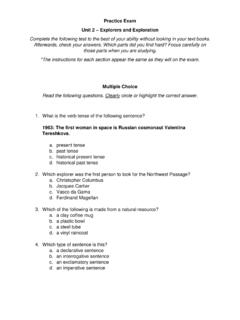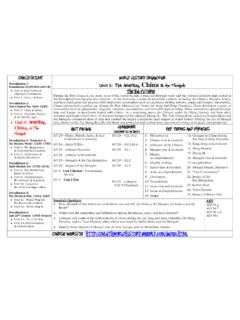Transcription of Unit 3: Early Civilizations and the Emergence of Pastoral ...
1 Seventh Grade Social Studies: Early World History SS0703. unit 3: Early Civilizations and the Emergence of Pastoral Peoples: 4000 to 1000 (Era 2). unit 3: Early Civilizations and the Emergence of Pastoral Peoples: 4000 to 1000 (Era 2). Big Picture Graphic Overarching Question: How did humans organize and interact within and across societies? Previous unit : This unit : Next unit : The Beginnings of Classical Traditions and Human Society: Early Civilizations and the Emergence Major Empires: 1000. Beginnings to 4000 of Pastoral Peoples: 4000 to 1000 300 (Era 3).
2 (Era 1) (Era 2). Questions To Focus Assessment and Instruction: Types of Thinking 1. How did geography shape the way in which people lived in Compare and Contrast various world zones during Era 2? Cause and Effect 2. How and why did Civilizations develop during Era 2? Evidentiary Argument Generalizing 3. What new problems and solutions emerged from living in Identifying perspectives Civilizations during Era 2? Problem Solving 4. What role did cultural diffusion play during Era 2? Research Michigan Citizenship Collaborate Curriculum Page 1 of 17.
3 Oakland Schools December 19, 2012. Seventh Grade Social Studies: Early World History SS0703. unit 3: Early Civilizations and the Emergence of Pastoral Peoples: 4000 to 1000 (Era 2). Graphic Organizer Michigan Citizenship Collaborate Curriculum Page 2 of 17. Oakland Schools December 19, 2012. Seventh Grade Social Studies: Early World History SS0703. unit 3: Early Civilizations and the Emergence of Pastoral Peoples: 4000 to 1000 (Era 2). High School Foundations (see World History and Geography). F1: World Historical and Geographical Habits of Mind and Central Concepts: Explain and use key conceptual devices world historians/geographers use to organize the past including periodization schemes ( , major turning points, different cultural and religious calendars), and different spatial frames ( , global, interregional, and regional).
4 F2: Systems of Human Organizations: Use the examples below to explain the basic features and differences between hunter-gatherer societies, Pastoral nomads, Civilizations , and empires, focusing upon the differences in their political, economic and social systems, and their changing interactions with the environment. o Changes brought on by the Agriculture Revolution including the environmental impact of settlements. o Two ancient river Civilizations , such as those that formed around the Nile, Indus, Tigris-Euphrates, Yangtze. Historical Overview: Historians and geographers see two dramatic and significant developments occurring during this era: (1) the rise of and interaction among Early agricultural-based Civilizations ( , river valley Civilizations ) and (2) growth of larger Pastoral communities.
5 The typical Western Civilization course focused on and devoted significant time to the four river valleys in Mesopotamia, China, India and Egypt and ignored Meso-America and the Pastoral peoples, except to mention their conquest of (or failure to conquer) a river valley civilization ( Hittite or Mycenaean Greeks or Aryans). World historians, however, see the era as being distinctive not only because of the growth of river valley Civilizations , and the interaction among the Indus, Nile and Euphrates Civilizations , but also because of the spread of agriculture throughout the world, the growth of Pastoral communities - some of which become quite militaristic in Eurasia and Africa - and the development of long- distance trade system in the Aegean and across Eurasia.
6 During this era new ways of organizing society -- Civilizations emerged as did some of our most fundamental inventions and discoveries, writing, mathematics. The era is also important because of the interactions and exchanges among various types of peoples and communities, specifically agrarian Civilizations and Pastoral peoples, in different regions. In essence, there developed three separate worlds or three separate patterns of global interactions: those in the Americas, Afroeurasia and Oceania. It is also possible to view Sub-Saharan African as having a different historical trajectory than the rest of Afroeurasia.
7 Some historians have argued that this era and subsequent one, established a biological ancien regime that found the majority of the human beings living in the environment, conscious of the limitations and opportunities the environment provided. 1 Agriculture provided not only food, but most of the industry and goods. Human life drew upon renewable energy sources and large governments developed to manage these relationships. This period also saw the development of key technologies which changed the ways humans lived, worked, and interacted, including bronze, the wheel, the plow, and other important innovations.
8 Crucial to understanding the changes in this era are the concepts of civilization, pastoralism, urbanization, agrarian civilization, militarization, empire, and theocracy. 1. Fernand Braudel, Civilization and Capitalism, 15th-18th Century (New York: Harper & Row, 1982), Chapter 1. Michigan Citizenship Collaborate Curriculum Page 3 of 17. Oakland Schools December 19, 2012. Seventh Grade Social Studies: Early World History SS0703. unit 3: Early Civilizations and the Emergence of Pastoral Peoples: 4000 to 1000 (Era 2). unit Abstract: This unit opens with students exploring in a general sense the term civilization ---the new way in which humans began to live during this era of history---and then discussing how historians use the term.
9 There is also an opportunity to review the chronology of the past unit and compare it to the time span of this unit , which is much shorter in comparison. The primary focus of the first lesson, however, is to help students analyze the crucial role of geography in the development of Early Civilizations along key river valleys in Afroeurasia. In particular, they learn about and then analyze Jared Diamond's theory of geographic luck using pictures, maps, and data tables in small groups or with partners. Students then study the four main River Valley Civilizations in Era 2 from a bird's eye view.
10 Specifically, students explore the characteristics of Sumer, Egypt, Indus River, and the Yellow (Huang He) River through map work, photo analysis and a reading activity. They also consider the role of geographic luck in the development of these four river valley Civilizations . They learn about the amount of time it took for Civilizations to develop once people started living in more complex villages and then explore how this process led to the development of new ideas---as Civilizations developed, new problems emerged which necessitated new solutions, and innovation occurred at a faster pace in a variety of areas including technology, government, culture and art, and writing.







